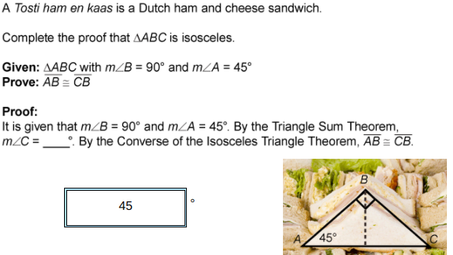What else can I help you with?
What must A measure in order for ABC to be isosceles?
Are you talking about the angle A. If you are then at what point of the triangle is the angle A.
Write a paragraph proof to show that the base angles of an isosceles trapezoid are congruent?
To prove that the base angles of an isosceles trapezoid are congruent, consider an isosceles trapezoid ( ABCD ) with ( AB \parallel CD ) and ( AD \cong BC ). By the properties of parallel lines, the angles ( \angle DAB ) and ( \angle ABC ) are consecutive interior angles formed by the transversal ( AD ) and ( BC ), respectively, thus ( \angle DAB + \angle ABC = 180^\circ ). Similarly, the angles ( \angle ADC ) and ( \angle BCD ) also sum to ( 180^\circ ). Since ( AD \cong BC ) and the trapezoid is isosceles, the two pairs of opposite angles must be equal, leading to ( \angle DAB \cong \angle ABC ) and ( \angle ADC \cong \angle BCD ), proving that the base angles ( \angle DAB ) and ( \angle ABC ) are congruent.
ABC is an isosceles right triangle AB has a slope of neg 1 and m ABC ninety degree's ABC is dilated by a sf of 1.8 with origin as center of dilation resulting in the image ABC what is slope of BC?
In an isosceles right triangle ( ABC ) with a right angle at ( B ) and ( AB ) having a slope of (-1), the slope of ( AC ) would be ( 1 ) since the two legs of the triangle are perpendicular. When the triangle is dilated with a scale factor of ( 1.8 ) from the origin, the slopes of the sides remain unchanged. Therefore, the slope of ( BC ), which is the leg opposite the right angle, remains ( 1 ).
If the median to a side of a triangle is also an altitude to that side then the triangle is isosceles How do you write this Proof?
Let the triangle be ABC and suppose the median AD is also an altitude.AD is a median, therefore BD = CDAD is an altitude, therefore angle ADB = angle ADC = 90 degreesThen, in triangles ABD and ACD,AD is common,angle ADB = angle ADCand BD = CDTherefore the two triangles are congruent (SAS).And therefore AB = AC, that is, the triangle is isosceles.
If an isosceles triangle has two equal sides that are 14 feet long and the third side is 17 feet long what are the angles?
Let the Isosceles Triangle be ∆ ABC with sides AB = AC = 14', and BC = 17' Draw a line bIsecting angle BAC. This line will be perpendicular to and bisect BC at point D. Then ∆ DBA (or ∆ DCA) is a right angled triangle with AB the hypotenuse. Angle ABD = Angle ABC is one of the two equal angles of the isosceles triangle. Cos ABD = BD/AB = 8.5/14 = 0.607143, therefore Angle ABC = 52.62° The third angle of the triangle is 180 - (2 x 52.62) = 180 - 105.24 = 74.76° The angles are therefore 52.62° , 52.62° and 74.76° .
complete the paragraph proof?
converse of the isosceles triangle theorem
If bd is both the altitude and median of abc then abc is?
Isosceles
what- Given ABC is isosceles with?
true
If is both the altitude and median of triangle ABC then triangle ABC is .?
It is isosceles.
If is both the altitude and median of triangle ABC then triangle ABC is?
It is isosceles.
If in ABC B is equal to C what kind of triangle is ABC?
Triangle ABC would be an isosceles. An isosceles triangle is defined as having two sides of equal length. This would also mean, then, that two angles in the triangle are also the same.
The parallelogram ABCD is a rhombus what type of triangle is ABC?
isosceles triangle
If triangle abc is an isosceles triangle what is the measure of side ab?
12 2
If triangle ABC is an isosceles triangle hat is the measure of side AB?
12squigally2
If ABC is an isosceles triangle with base AC what is the measure of C?
30 degrees
if an isosceles triangle ABC is dilated by a scale factor of 3, which of the following statements is not true?
the sides of ABC are congruent to the sides of A'B'C'
which completes the paragraph proof?
converse of the isosceles triangle theorem

